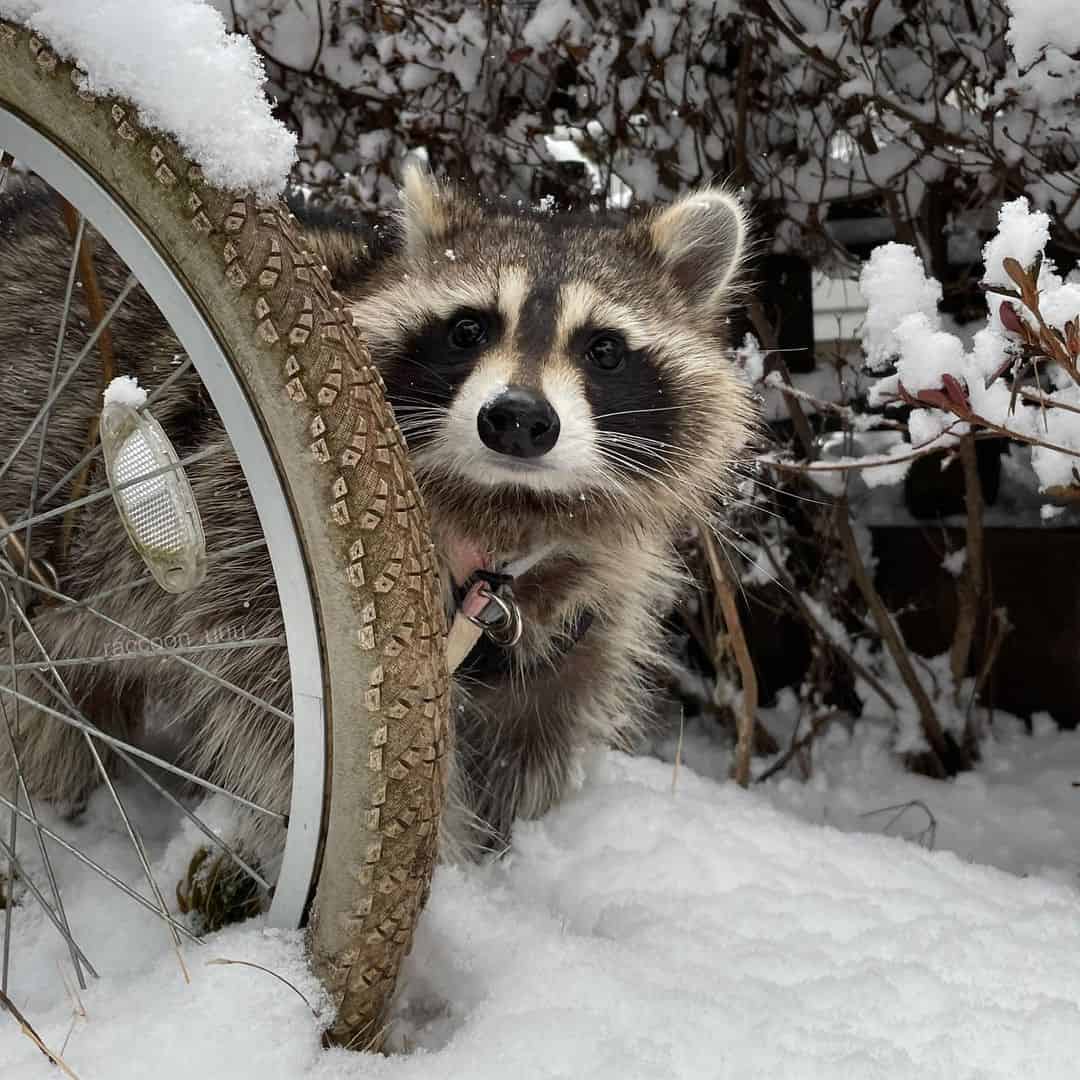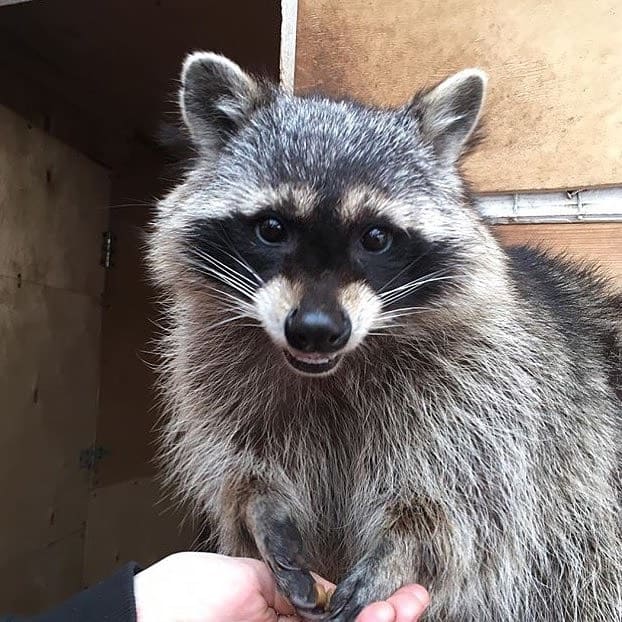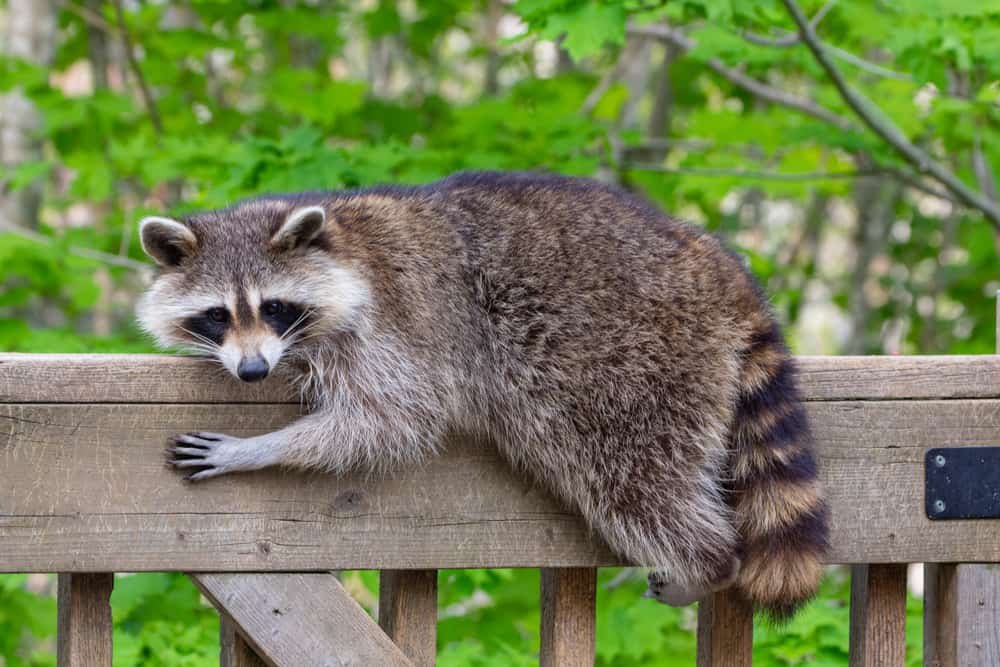Raccoons make various sounds depending on the action accompanied by the noise – this makes it difficult to determine whether what you’re identifying is in fact a raccoon or not.
If you hear indistinguishable animal sounds during night hours, it might be a raccoon. This nocturnal mammal leaves its den at sunset for a food hunt and stays active during the nighttime. Raccoons can make more than 200 different sounds to communicate, search for food when fighting, and protect their den from predators.
Besides making hundreds of vocal sounds, raccoons make several types of sounds when moving around.
We’ve put together an article explaining types of raccoon noises, the sounds produced during movement, and relevant information to help you identify the sounds raccoons make.
Common Raccoon Sounds
1. Hiss and Growl
Raccoons are friendly creatures and don’t get aggressive unless they sense danger or feel threatened. However, if they feel about being trapped or perceive their life to be in danger, they start making defensive hissing and growling sounds.
Besides making defensive sounds, these creatures exhibit defensive body language, showing their teeth and claws. Typically mother raccoons portray this defensive stance if she feels their cubs are in danger.
2. Chatter
It’s one of the most common sounds and has slightly varying meanings when used in different contexts. When raccoons communicate with each other, they make this chittering sound. Raccoon babies also make a similar sound when approaching their mother.
Other instances when the chittering sound can be heard include during a food search and when exploring the surroundings.
The intensity of these sounds increases significantly during the mating season when female raccoons make a mating call to male raccoons. This breeding season starts in January and ends in March.
3. Purring
This sound is produced mainly by tiny cubs living in the den. They make this purring sound when their mother is in contact. The babies will keep making this sound, whether the mother licks, feeds, or just lies close to the cubs. This sound is similar to a cat purring and means the animal is showing affection and is happy.
4. Barking
Raccoons can bark like dogs but don’t make this sound unless they are under extreme stress or suffering from an ailment. You might also hear this sound if the animal is stuck or when a mother raccoon can’t find her babies inside the den.
5. Screeching
Screaming and squealing sounds are heard when raccoons are fighting. The raccoon snarls at their enemy, warning them to back off. This screeching sound is similar to a screech owl. If you hear this sound more often, it can indicate the raccoon is in severe distress and might need adequate care.
Raccoon Sounds During Movement

Besides hearing these vocalizations, raccoons make several other sounds that can be heard clearly during quiet hours. Here’s a short list of the familiar sounds:
1. Scratching Sound
The sound can be heard if the raccoon is around or in the household. They have sharp claws that can make this scratching noise when in contact with hard surfaces.
A raccoon might be climbing the chimney, roaming on rooftops, or climbing the pipes. They mostly find small openings like a crawl spaces between walls and try to make their way in.
2. Rustling Sound
In the wild, raccoons climb trees to gather food and salvage food from the surroundings. However, in urban and suburban dwellings, the most accessible food sources are garbage cans which raccoons love to dig in. This rustling sound is heard when the raccoon dives into garbage cans in search of food.
This sound is typically heard during nighttime. However, if this sound becomes intense and you start hearing it regularly, it could mean the raccoon has gained entry into the household. The rustle is produced when the animal slides against the attic’s wooden beams or when tearing up the wall insulation.
3. Dragging
Healthy raccoons can weigh up to 15 pounds. Their underbelly and fur produce a dragging sound. A dragging sound will be made when a raccoon moves on a hard surface like tiles or wooden flooring. This dragging sound becomes more evident if the raccoon is obese or suffers from a disease affecting their movement.
Sounds Produced by Rabid Raccoons

These rabid raccoons sound like a hiss, squeal, or screech. Virtually every healthy raccoon produces these sounds but it has an associated action.
On the contrary, a rabid raccoon will keep barking, making squealing noises more often, especially when alone. These animals are primary carriers of rabies and can transfer the disease to other animals.
Even when there’s no danger around, a rabid raccoon will feel threatened, keep making these hissing sounds, and will not hesitate to attack animals or humans. A rabid raccoon will also exhibit some evident visual cues.
If the infection is severe, the raccoon can have difficulty during movement and might even suffer from paralysis. Their fur will look dry, and the animal will seem confused, agitated, and disoriented. Some raccoons can even foam from their mouths.
Raccoon Sounds When Climbing Walls
Raccoons can scale walls only to find a spot to enter through. If they see an opening, the raccoons can go into the crawlspace, producing a lot of noise, especially at night. You’ll hear frequent thumping, scratching, and dragging sounds as the animal starts to make way.
While it is nearly impossible for a raccoon to damage a wall or make an entry point, homes with wooden siding are different from the raccoon. Their jaws are strong enough to nibble through wood and can easily make new entry points until the owner notices.
Raccoon Sounds in the Attic
If the raccoons have made their way into the attic, you will mostly hear scratching and nibbling sounds where the raccoon will either make a small hole or gather insulation material to use in making their den.
Scraping, hearing these usual sounds. Hearing high-pitched screeching and purring sounds means the raccoon has already settled in and has made the indoors their new home.
If you see these signs in a raccoon, it’s best to call pest control services or animal welfare for raccoon removal and provide the required care and treatment. Avoid catching the raccoon yourself, as they can potentially scratch and bite.
Signs of Raccoon Infestation

If you hear sounds similar to the ones we shared, there’s a possibility of a raccoon infestation. Here are some other signs you can look for:
- Raccoon droppings near garbage cans, rooftops, or other food sources.
- Garbage cans and waste disposal bags toppled over.
- Scratch marks on the doors, pipes, and exterior walls.
- Small bits of food are scattered over the floor near your trash cans.
- The raccoons can bring other food items or trash and leave them in your yard.
While raccoons look adorable, they are considered pests and can infest an area, mating and raising young raccoons within a few months.
Preventative Measures
If your area is infested with raccoons, you will hear a lot of movement noise around the clock. Besides exploring trash cans, these creatures will search for food around the area. For example, if a raccoon finds its way into the house through a small opening in the garage door, it will not hesitate to explore further and look for consumables.
These animals can come in through open windows, climb down chimneys, and can even find a safe spot to stay inside. Here are some preventative measures to implement if you want to keep the raccoons from entering the property:
- Use an outdoor scat mat to prevent raccoons and other animals from entering the premises. These mats provide a privileged barrier that the raccoon feels uncomfortable while crossing. The best place to put scat mats is the front of the entry and exit points like that garage, backyard door, or entryway.
- Raccoons can smell food and follow the scent to get to the food source. Keep the food waste tightly sealed in garbage bags, and avoid leaving food leftovers in the open.
- You can either make a DIY raccoon repellent or use a commercial repellent to keep the raccoons out.
- Keep the property clean and look for any small openings that raccoons can use to break in.
- Install fencing around the property to prevent their entry.
Final Thoughts
Identifying animals in your area can aid in taking the proper preventative measures and avoiding problems in the long run. Here’s a quick recap so you can take advantage of crucial details.
Raccoons can vocalize with each other and make distinct sounds in social interactions and when exhibiting several moods. For example, baby raccoons make purring sounds near their mother, whereas a raccoon might bark when distressed. Furthermore, these raccoons can produce a scratching or rustling sound while on the move.
While these furry creatures seem harmless, they potentially carry diseases like rabies, which can spread to nearby pets and animals.
Whether you hear sounds similar to what we shared or have already identified a raccoon within the premises, it’s imperative to stay alert and take the required preventative measures to keep the raccoons from damaging the property.
